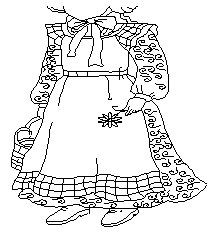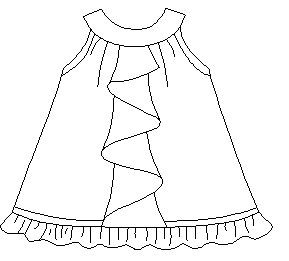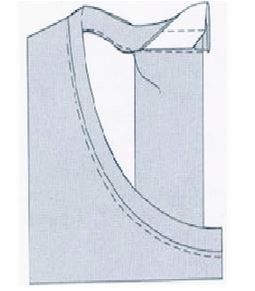Garments sketching and Making – Kids wear / वस्त्र स्केचिंग और बनाना – बच्चों के वस्त्र
⬇ नीचे दिये गये START QUIZ पर क्लिक करें ⬇
Q1. Which is a unisex garment? / यूनिसेक्स परिधान कौन सा है?
Q2. Which fasteners are preferred for back open jhablas? / पीछे से खुले झबले के लिए कौन से फास्टनर पसंद किए जाते हैं?
Q3. What is the name of the frock shown in figure? / फिगर में दिखाई गई फ्रॉक का नाम क्या है?

Q4. Which fastener is used in new born baby garment? / नवजात शिशु के परिधान में किस फास्टनर (बन्धक) का उपयोग किया जाता है?
Q5. What is the cause in main garment if chemise neckline visible out of main garment? / मुख्य परिधान में अगर क़मीज़ नेकलाइन मुख्य परिधान से बाहर दिखाई देती है तो इसका कारण क्या है?
Q6. Where bias facing is used? / बायस फेसिंग का उपयोग कहाँ किया जाता है?
Q7. What is the name of special attachment shown in figure? / फिगर में दिखाए गए विशेष अटैचमेंट का नाम क्या है?

Q8. Which fabric is preferred for kids? / बच्चों के लिए कौन सा फैब्रिक पसंद किया जाता है?
Q9. How to cut the placket piece for jhabla opening? / झबले की ओपनिंग के लिए प्लैकेट पीस कैसे काटें?
Q10. Which fabric is preferred for baby chemise? / बेबी केमिज़ के लिए कौन सा फैब्रिक पसंद किया जाता है?
Q11. Why frocks made by knitted fabrics should be without too many seams and darts? / बुने हुए कपड़ों से बने फ्रॉक बहुत अधिक सीम और डार्ट के बिना क्यों होने चाहिए?
Q12. What is the name of layout for baby set shown in figure? / फिगर में दिखाए गए बेबी सेट के लेआउट का नाम क्या है?

Q13. How to take the measurement for skirt part? / स्कर्ट हिस्से के लिए माप कैसे लें?
Q14. How to calculate material for bell shape garment? / बैल (घंटी) के आकार के परिधान के लिए सामग्री की गणना कैसे करें?
Q15. What is the name of garment shown in figure? / फ़िगर में दिखाए गए गारमेंट्स का नाम क्या है?

Q16. How to calculate the skirt length of frock? / फ्रॉक की स्कर्ट की लंबाई की गणना कैसे करें?
Q17. Which is the width wise measurement? / चौड़ाई के हिसाब से माप कौन सा है?
Q18. Which age groups for new born babies? / नवजात शिशुओं के लिए कौन सा आयु वर्ग होता है?
Q19. What is the length of shorts? / शॉर्ट्स की लंबाई क्या होती है?
Q20. What is the name of dress shown in figure? / फिगर में दिखाई गई ड्रेस का नाम क्या है?

Q21. Which stitch is used to create a gathering? / गेदरिंग बनाने के लिए किस सिलाई (स्टिच) का उपयोग किया जाता है?
Q22. What is the name of the toddler dress as shown in figure? / चित्र में दिखाए गए बच्चे के ड्रेस का नाम क्या है?

Q23. Which seam is used in baby chemise? / बेबी केमिस में किस सीम का उपयोग किया जाता है?
Q24. What is the purpose of gathering foot? / गेदरिंग फुट का उद्देश्य क्या है?
Q25. Which side to stitch the crotch line of the shorts? / शॉर्ट्स की क्रॉच लाइन के लिए कौन सी साइड सिलते हैं?
Q26. Where expanded facing is used in garment? / गारमेंट्स में विस्तारित फेसिंग का उपयोग कहाँ किया जाता है?
Q27. Which side of the placket is preferred by jhabla? / झबला हेतु किस तरफ के प्लैकेट को वरीयता दी जाती है?
Q28. Which is toddler stage? / टॉडलर्स स्टेज (शिशु अवस्था) कौन सी होती है?
Q29. Which collar is used in umbrella frock? / अम्ब्रेला फ्रॉक में किस कॉलर का उपयोग किया जाता है?
Q30. Which type of garments is used in baby chemise? / बेबी केमिस में किस प्रकार के गारमेंट्स का प्रयोग किया जाता है?
Q31. Which sleeves is used in umbrella frock? / अम्ब्रेला फ्रॉक में कौन सी स्लीव का प्रयोग किया जाता है?
Q32. Which type of neck finishing as shown in figure? / चित्र में नेक की फिनिशिंग किस प्रकार की दर्शाई गई है?

Q33. Which is combination suit in kids wear? / बच्चों के पहनावे में कॉम्बिनेशन सूट कौन सा है?
Q34. Which garment have neck line deeper and wider? / किस गारमेंट्स में नेक लाइन गहरी और चौड़ी होती है?
Q35. Which tuck starts from a point and end somewhere in middle? / कौन सा टक एक पॉइंट से शुरू होता है और बीच में कहीं ख़त्म होता है?
Q36.Which stage the growth of body is fast? / शरीर का विकास किस चरण में तेज होता है?
Q37. Which is the major requirements for a new born babies dresses? / नवजात शिशुओं की ड्रेस के लिए प्रमुख आवश्यकताएं क्या हैं?
Q38. Which is basic children wear? / बच्चों का मूल वस्त्र कौन सा है?
Q39. What is the purpose of wearing slip inside outer garment made of fine fabric? / महीन कपड़े से बने बाहरी परिधान के अंदर स्लिप पहनने का उद्देश्य क्या है?
Q40. How to calculate the facing width for jhabla? / झबले के लिए फेसिंग चौड़ाई की गणना कैसे करें?
Q41. How many cut components in front open sleeveless jhabla? / सामने से खुले स्लीवलेस झबला में कितने कट कॉम्पोनेन्ट (घटक) होते हैं?
Q42. What is the name of garment shown in figure? / फिगर में दिखाए गए गारमेंट्स का नाम क्या है?

Q43. What is the name of part marked X? / भाग X का नाम क्या है?

Q44. Which stage is called childrenʹs stage? / किस चरण को बच्चों का चरण कहा जाता है?
Q45. Which type of folding used for bodice? / किस प्रकार की फोल्डिंग (तह) का उपयोग बोडिस (चोली) के लिए किया जाता है?

Q46. Which measurement is used for jangia? / जांघिया के लिए किस माप का उपयोग किया जाता है?
Q47. How to measure the bodice length? / बॉडीस की लंबाई कैसे मापें?
Q48. What is the name of the stitch shown in figure? / फिगर में दिखाई गई स्टिच का नाम क्या है?

Q49. Which type of binding used in sheer fabrics? / शीयर वस्त्रों में किस प्रकार के बंधन का उपयोग किया जाता है?
Q50. What is advantage of using cotton fabrics in making frocks? / फ्रॉक बनाने में सूती कपड़े का उपयोग करने का फायदा क्या है?
Sewing Technology 1st Year Module 10 Garments sketching and Making - Kids wear
You got {{userScore}} out of {{maxScore}} correct
{{title}}
{{image}}
{{content}}